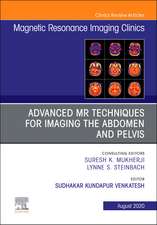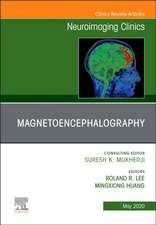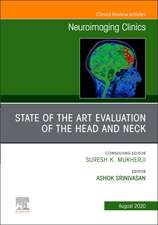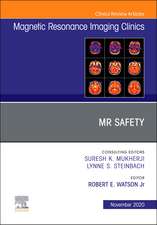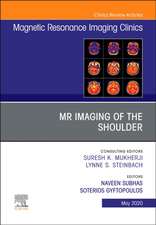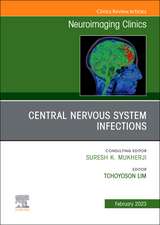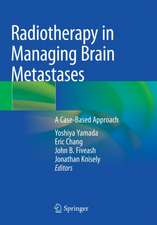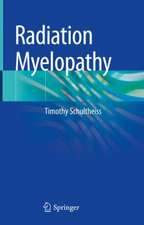Engineering Patient Safety in Radiation Oncology: University of North Carolina’s Pursuit for High Reliability and Value Creation
Autor Lawrence Marks, Lukasz Mazur, Bhishamjit Chera, Robert Adamsen Limba Engleză Hardback – apr 2015
Engineering Patient Safety in Radiation Oncology describes proven concepts and examples, borrowed from organizations known for high reliability and value creation, to guide radiation oncology centers towards achieving patient safety and quality goals. It portrays the authors’ efforts at the University of North Carolina to address the challenges of keeping patients safe while continuously improving care delivery processes.
- Reviews past and current challenges of patient safety issues within radiation oncology
- Provides an overview of best practices from high reliability organizations
- Explains how to optimize workplaces and work processes to minimize human error
- Offers methods for engaging and respecting people during their transition to safety mindfulness
Preț: 446.73 lei
Nou
Puncte Express: 670
Preț estimativ în valută:
85.55€ • 87.30$ • 71.98£
85.55€ • 87.30$ • 71.98£
Carte tipărită la comandă
Livrare economică 26 februarie-12 martie
Preluare comenzi: 021 569.72.76
Specificații
ISBN-13: 9781482233643
ISBN-10: 1482233649
Pagini: 312
Ilustrații: 123 black & white illustrations, 17 black & white tables
Dimensiuni: 156 x 234 x 20 mm
Greutate: 1.25 kg
Ediția:1
Editura: Taylor & Francis
Colecția Productivity Press
Locul publicării:Oxford, United Kingdom
ISBN-10: 1482233649
Pagini: 312
Ilustrații: 123 black & white illustrations, 17 black & white tables
Dimensiuni: 156 x 234 x 20 mm
Greutate: 1.25 kg
Ediția:1
Editura: Taylor & Francis
Colecția Productivity Press
Locul publicării:Oxford, United Kingdom
Public țintă
Professional Practice & DevelopmentCuprins
Broad Overview of "Past" and "Current" Challenges of Patient Safety Issues in Radiation Oncology. Best Practices from High-Reliability and Value Creation Organizations: Their Application to Radiation Oncology. Driving Change at the Organizational Level. Driving Change at the Workplace Level. Driving Change at the People Level. Research. Conclusion.
Recenzii
This is a timely and important book that speaks from the experiences and the hearts of prominent radiation oncologists who fought for a structure that better serves patient safety. Its starting point is not deficient practitioners or their errors, but instead the realization that ‘we put workers into suboptimal environments and then wonder why things go wrong.’ In tracing what is responsible for things going wrong, rather than who is responsible, the book examines the organizational, workplace and people levels, taking time to stop and reflect on what works and what doesn’t. What makes this book so powerful is that it is not just an argument, but a narrative about the experiences of trying to make this work in a large hospital system. Many who are in similar positions as the authors—as well as those at the receiving or approving ends of their kind of ideas—will quickly recognize the many possibilities, frustrations, twists, turns and elations in the journey toward greater patient safety.
—Sidney Dekker, PhD, Professor Safety Innovation Lab, Griffith University, and Royal Children's Hospital, Brisbane, Australia
The solution to risky complexity lies in simple processes, teamwork, repetition, verification, and a culture of safety. These authors bring a much needed framework to the increasingly complex and dangerous field of radiation therapy.
—Anthony L. Zietman, MD FASTRO, Jenot W. and William U. Shipley Professor of Radiation Oncology, Department of Radiation Oncology, Harvard Medical School; Associate Director, Radiation Oncology Residency Program, Massachusetts General Hospital
With his signature common sense approach and clarity of purpose, Larry Marks and his team have produced a new must-read addition to the canon of radiation oncology literature. As recognized experts in the field, they have created a living laboratory for quality improvement in the UNC Department of Radiation Oncology that now serves as a leading exemplar of a workplace culture of safety. This book provides a blueprint for how to emulate their success and should be read by radiation oncologists, radiation oncology residents, medical physicists, radiation therapists, radiation therapy nurses, dosimetrists, radiation oncology department managers, and anyone else who is involved in the care of patients receiving any form of radiation therapy. In fact, anyone studying the burgeoning new discipline of the science of patient safety will find not only an excellent review of basic principles but also many wonderful case study-type practical examples of applied patient safety science.
—Brian D Kavanagh, MD, MPH, FASTRO, Professor, Vice-chairman, Clinical Practice Director, Department of Radiation Oncology, University of Colorado School of Medicine
The new textbook Engineering Patient Safety in Radiation Oncology by Marks and Mazur is a very interesting textbook that covers key aspects of safety for radiation medicine professionals. Section I, chapters 1-3, sets the scene with background on radiation oncology and a detailed discussion of high reliability organizations. Section II, chapters 4-8, begins with an in-depth presentation of change management at the organizational, workplace, and people levels. This is followed by research aspects of patient safety including future possible research directions related to patient safety in radiation oncology for interested academicians. The book draws on years of academic and practical experience of the authors. Many examples are taken out of the authors’ clinical experience, which makes this textbook required reading for practicing clinicians interested in improving safety for their patients. The text is clear and concise making the concepts accessible to all members of the radiation oncology team. Both basic and advanced concepts are covered in detail with practical examples. Anyone interested in learning about safety in radiation oncology or moving the safety knowledge to the advanced level should read this book. Even radiation oncology safety experts will benefit from the authors’ experience shared in Engineering Patient Safety in Radiation Oncology.
—Todd Pawlicki, PhD, FAAPM, Professor and Vice-Chair of Medical Physics, Division Director, Department of Radiation Medicine and Applied Sciences, University of California, San Diego
The safe delivery of high-quality radiation treatment for cancer patients relies on a multidisciplinary team of highly skilled professionals performing complex tasks in a technology-rich, yet patient friendly and compassionate environment. This outstanding book provides a comprehensive overview of cultural, leadership, organizational and systematic issues and challenges while offering sound, practical, industrial engineering based approaches to optimizing the delivery of radiation.
This must read book for anyone on the radiation oncology team not only promotes a culture of the safe delivery of radiation, but demonstrates the potential barriers and offers practical, reproducible long term solutions. It demonstrates the importance of embracing the concept of patient safety mindfulness throughout the entire organizational structure.
The book provides a unique perspective as to how human behavior, leadership styles, and the workplace environment contribute to the culture of safety in radiation oncology, and most importantly insights as to how to modify these factors to optimize and reliably deliver high quality safe radiation treatment. Organizational leaders, hospital/health care administrators, and all of the professionals involved in the specialty of radiation oncology will benefit from the messages delivered in this practical book.
The book provides practical and reliable solutions to manage effective processes and communication in the safe delivery of quality radiation therapy.
—Bruce G. Haffty, MD, Professor and Chair, Dept. Radiation Oncology, Rutgers, Cancer Institute of New Jersey; Robert Wood Johnson Medical School, New Jersey Medical School
The book demonstrates a critical point in maintaining a culture of safety in the delivery of radiation—the requirement that a culture of safety depends not only on technical and procedural factors, but attention to infrastructure, attitude, human and environmental factors.
Driven by rapidly evolving technology, increasing demand for services and new treatment and imaging modalities, the world of radiation therapy is becoming increasingly more complex. This cutting edge book provides a conceptual framework to design, implement, and evaluate operational models that increase radiation therapy efficiency and effectiveness through proven and dynamic engineering concepts. The outcomes are increased value, productivity, and patient safety. The book creates a different and emerging type of knowledge, and is a must read for the international community of radiation oncology leaders, students, and practitioners.
—John French, Senior Director, Provincial Radiation Therapy Program, British Columbia Cancer Agency, Vancouver, Canada
Larry Marks’ book is essential reading for any radiation oncology facility interested in a meaningful quality and safety program. It is a comprehensive review written from an engineering perspective, but is presented in a way that is both approachable and useful for physicians and administrators who lack such a technical fluency. With the increasing complexity of the specialty, and the emerging scrutiny from payers who are demanding documentable efforts at quality and safety, this book offers many valuable insights for those who are integrating this critical aspect of patient care into their programs.
—Tim R. Williams, MD, Medical Director, Radiation Oncology, The Lynn Cancer Institute, Boca Raton Regional Hospital
—Sidney Dekker, PhD, Professor Safety Innovation Lab, Griffith University, and Royal Children's Hospital, Brisbane, Australia
The solution to risky complexity lies in simple processes, teamwork, repetition, verification, and a culture of safety. These authors bring a much needed framework to the increasingly complex and dangerous field of radiation therapy.
—Anthony L. Zietman, MD FASTRO, Jenot W. and William U. Shipley Professor of Radiation Oncology, Department of Radiation Oncology, Harvard Medical School; Associate Director, Radiation Oncology Residency Program, Massachusetts General Hospital
With his signature common sense approach and clarity of purpose, Larry Marks and his team have produced a new must-read addition to the canon of radiation oncology literature. As recognized experts in the field, they have created a living laboratory for quality improvement in the UNC Department of Radiation Oncology that now serves as a leading exemplar of a workplace culture of safety. This book provides a blueprint for how to emulate their success and should be read by radiation oncologists, radiation oncology residents, medical physicists, radiation therapists, radiation therapy nurses, dosimetrists, radiation oncology department managers, and anyone else who is involved in the care of patients receiving any form of radiation therapy. In fact, anyone studying the burgeoning new discipline of the science of patient safety will find not only an excellent review of basic principles but also many wonderful case study-type practical examples of applied patient safety science.
—Brian D Kavanagh, MD, MPH, FASTRO, Professor, Vice-chairman, Clinical Practice Director, Department of Radiation Oncology, University of Colorado School of Medicine
The new textbook Engineering Patient Safety in Radiation Oncology by Marks and Mazur is a very interesting textbook that covers key aspects of safety for radiation medicine professionals. Section I, chapters 1-3, sets the scene with background on radiation oncology and a detailed discussion of high reliability organizations. Section II, chapters 4-8, begins with an in-depth presentation of change management at the organizational, workplace, and people levels. This is followed by research aspects of patient safety including future possible research directions related to patient safety in radiation oncology for interested academicians. The book draws on years of academic and practical experience of the authors. Many examples are taken out of the authors’ clinical experience, which makes this textbook required reading for practicing clinicians interested in improving safety for their patients. The text is clear and concise making the concepts accessible to all members of the radiation oncology team. Both basic and advanced concepts are covered in detail with practical examples. Anyone interested in learning about safety in radiation oncology or moving the safety knowledge to the advanced level should read this book. Even radiation oncology safety experts will benefit from the authors’ experience shared in Engineering Patient Safety in Radiation Oncology.
—Todd Pawlicki, PhD, FAAPM, Professor and Vice-Chair of Medical Physics, Division Director, Department of Radiation Medicine and Applied Sciences, University of California, San Diego
The safe delivery of high-quality radiation treatment for cancer patients relies on a multidisciplinary team of highly skilled professionals performing complex tasks in a technology-rich, yet patient friendly and compassionate environment. This outstanding book provides a comprehensive overview of cultural, leadership, organizational and systematic issues and challenges while offering sound, practical, industrial engineering based approaches to optimizing the delivery of radiation.
This must read book for anyone on the radiation oncology team not only promotes a culture of the safe delivery of radiation, but demonstrates the potential barriers and offers practical, reproducible long term solutions. It demonstrates the importance of embracing the concept of patient safety mindfulness throughout the entire organizational structure.
The book provides a unique perspective as to how human behavior, leadership styles, and the workplace environment contribute to the culture of safety in radiation oncology, and most importantly insights as to how to modify these factors to optimize and reliably deliver high quality safe radiation treatment. Organizational leaders, hospital/health care administrators, and all of the professionals involved in the specialty of radiation oncology will benefit from the messages delivered in this practical book.
The book provides practical and reliable solutions to manage effective processes and communication in the safe delivery of quality radiation therapy.
—Bruce G. Haffty, MD, Professor and Chair, Dept. Radiation Oncology, Rutgers, Cancer Institute of New Jersey; Robert Wood Johnson Medical School, New Jersey Medical School
The book demonstrates a critical point in maintaining a culture of safety in the delivery of radiation—the requirement that a culture of safety depends not only on technical and procedural factors, but attention to infrastructure, attitude, human and environmental factors.
Driven by rapidly evolving technology, increasing demand for services and new treatment and imaging modalities, the world of radiation therapy is becoming increasingly more complex. This cutting edge book provides a conceptual framework to design, implement, and evaluate operational models that increase radiation therapy efficiency and effectiveness through proven and dynamic engineering concepts. The outcomes are increased value, productivity, and patient safety. The book creates a different and emerging type of knowledge, and is a must read for the international community of radiation oncology leaders, students, and practitioners.
—John French, Senior Director, Provincial Radiation Therapy Program, British Columbia Cancer Agency, Vancouver, Canada
Larry Marks’ book is essential reading for any radiation oncology facility interested in a meaningful quality and safety program. It is a comprehensive review written from an engineering perspective, but is presented in a way that is both approachable and useful for physicians and administrators who lack such a technical fluency. With the increasing complexity of the specialty, and the emerging scrutiny from payers who are demanding documentable efforts at quality and safety, this book offers many valuable insights for those who are integrating this critical aspect of patient care into their programs.
—Tim R. Williams, MD, Medical Director, Radiation Oncology, The Lynn Cancer Institute, Boca Raton Regional Hospital
Notă biografică
Lawrence Marks was born and raised in Brooklyn, New York. He studied chemical engineering at Cooper Union and obtained his MD from the University of Rochester. He did his residency training in radiation oncology at Massachusetts General Hospital and then served on the faculty of Duke University for 19 years. There, he studied radiation-induced normal tissue injury and became interested in human factors engineering and patient safety. In 2008, he moved to the University of North Carolina to become the Dr. Sidney K. Simon Distinguished Professor of Oncology Research and the chairman of the Department of Radiation Oncology. Over the last six years, he and Dr. Mazur and others have been systematically applying engineering principles from high-reliability and value creation organizations to improve safety. In his clinical work, he has particular interest in the care of patients with cancers of the lung or breast. He has been active in ASTRO (American Society for Radiation Oncology) and currently serves on its Board of Directors as the chairman of the Clinical Affairs and Quality Council. He lives with his wife of 29 years, Caryn Hertz, in Chapel Hill. They have three sons, none of whom is planning a career in medicine.
Lukasz Mazur earned his BS, MS, and PhD in industrial and management engineering from Montana State University. As a student athlete at Montana State University, he earned a spot in the Bobcats Hall of Fame for his efforts on a tennis team. While working at North Carolina State University, he was awarded the Alumni Outstanding Extension Service Award for his outreach work, highlighting his passion for quality and safety work in the healthcare industry. Currently, he is an assistant professor in the Radiation Oncology Department at the UNC School of Medicine. His research interests focus on engineering management as it pertains to continuous quality and safety improvements and human factor engineering with a focus on worklo
Lukasz Mazur earned his BS, MS, and PhD in industrial and management engineering from Montana State University. As a student athlete at Montana State University, he earned a spot in the Bobcats Hall of Fame for his efforts on a tennis team. While working at North Carolina State University, he was awarded the Alumni Outstanding Extension Service Award for his outreach work, highlighting his passion for quality and safety work in the healthcare industry. Currently, he is an assistant professor in the Radiation Oncology Department at the UNC School of Medicine. His research interests focus on engineering management as it pertains to continuous quality and safety improvements and human factor engineering with a focus on worklo
Descriere
This book supplies proven concepts and examples to guide radiation oncology centers towards achieving patient safety and quality goals. It portrays the authors’ efforts at the University of North Carolina to address the challenge of keeping patients safe while continuously improving care delivery processes. Requiring no prior knowledge of high reliability and value creation, the book begins by introducing the basic concepts, methods, and tools that underlie the authors’ approach to high reliability and value creation. Part two provides an in-depth account of their journey to high reliability and value creation.



